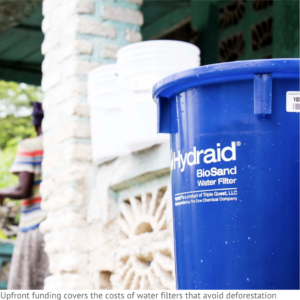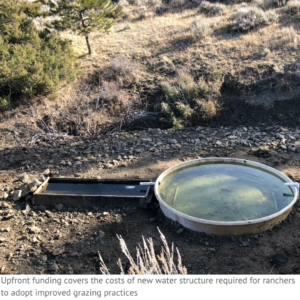By Jennifer Cooper, Claire Lafave, and Tom Stoddard
The mitigation hierarchy and civil society dictate that a company implementing a climate mitigation strategy should first prioritize measuring its climate footprint. Second, implement an ambitious emissions reduction plan, continually investing to lower emissions. And third, take responsibility for residual emissions. While this is the order of priority, it need not be the order of completion. Implementing your climate change strategy doesn’t have to be like building a piece of Ikea furniture (think: make sure you’ve completed each step perfectly before you move on to the next); rather it can be like working out (think: the more you do, the better, but every little bit is good for you and there’s no one way to do it). One way of thinking about residual emissions is the hard-to-abate emissions that still exist after a company has completed steps one and two. But how long will those steps take? And are we, as company representatives, as citizens of this earth, willing to wait? The other way to think about residual emissions is a company’s emissions that are not being avoided or reduced today. We know that the world needs to take urgent action now to build the capacity to cut emissions in half by 2030. We believe that companies, alongside their first priorities of measuring and reducing, should take responsibility for their residual emissions today. Not only by balancing those emissions one-for-one, but by investing to catalyse the lasting, system level change we need in place before 2030.
Fund a New Climate Intervention to Catalyze Change

In our experience, one efficient, high-impact method for catalyzing change is to identify climate interventions that require upfront funding to move forward. It is our aim to focus our work on enabling these types of interventions. After fully vetting and quantifying the impact of the climate action, we invite companies to forward purchase the projected carbon credits associated with it. In buying future credits associated with a new climate initiative upfront, companies cover the initial cost hurdles of the intervention. As the credits are issued over the lifetime of the project, they are retired on behalf of the supporting companies.
This is a different prospect than identifying an existing project and purchasing credits that have already been issued. Companies that purchase credits from existing projects – purchase backward instead of purchase forward — do not directly cause new reduction and removal projects. They do cause new capacity indirectly by signalling demand, if those signals effectively reach the market and ultimately cause new capacity to be built in subsequent years. As such, this type of project support remains an important part of climate action, but is less impactful than many companies are aiming for for their investment.
There is another reason, beyond catalyzing new capacity, that companies should include support for projects through forward purchases in their work; these models allow the voluntary market to bring on new, innovative project types with the highest levels of additionality and support for project stakeholders. Projects that need offset revenues to be implemented can be viewed in two categories – those that have an investor willing to take the risk that offset revenues will be forthcoming (type 1), and those that do not (type 2). Without forward purchasing, only type 1 projects are built. Those projects are likely to be the most obviously financially viable and the least risky, and are likewise likely to be limited to well recognized interventions (such as forestry) that are less additional (more likely to be occurring without offset buyers’ support). One reason these projects may be less risky or less costly to support is because they put the risk, and the initial burden of change, on the project stakeholders. For example, many agricultural projects will only pay a farmer or rancher for carbon credits associated with regenerative practices after the farmer has made the transition and the change in greenhouse gas emissions or removals has been quantified and verified. This can take multiple years. Farmers then bear the cost of the transition, often without support or training, and then have to take a risk on the carbon market to cover their costs and provide a return. But through forward purchasing, companies commit to supporting a farmer through their transition, ensuring a much higher likelihood of success.

An example: A company that uses leather in its products wants to catalyze new climate action through funding carbon removal activities in leather production. That company can support our Northern Great Plains Regenerative Grazing project by forward purchasing carbon credits that will be issued in the first 5-7 years of the project’s operation. In our contract with the company, we commit to providing them with the number of credits they have purchased. The company’s upfront financing goes to cover the rancher’s funding gap, the cost of transition – the costs for fencing, water infrastructure, training, and increased labor associated with adaptive rotational grazing. As the credits derived from increased carbon accrual in the soil associated with these new practices are quantified and issued, they are retired on behalf of the supporting company. In this way, the company’s purchase enables and expands the project, building new, lasting climate mitigation capacity.
With every forward purchase, as with any offset purchase, it is important to confirm the project issues verified credits for the emissions reductions or removals you purchased and that those credits are retired on your behalf. This visibility is essential for all types of offset purchases, whether the emissions were reduced or removed several years before you purchased the credits, or whether they will be reduced or removed several years after you purchase the credits.
Communicate Your Ambitions and Results, Clearly and In Detail
Our leading recommendation on climate claims is that you focus your energies first on creating the lasting impact you want to make as a company. Then consider what you want to say about it.
So, can you claim “neutral” status if you forward purchase? Yes. Companies that make forward purchases on an annual basis to balance their emissions should be able to claim neutral status because the lifetime emissions of the company are being offset by the lifetime reduction and removal credits from the projects within a reasonable timeframe. If you wish to forward purchase and claim neutral status, here are some things to consider:
- If you wish to publicly report on your contribution, it is essential to clearly convey the year your emissions occurred and the time period over which those emissions will be balanced. This clear conveyance of what ‘neutral’ means is not unique to forward purchasing, but rather fundamental to all good climate claims and communications (that is, you should do the same if you offset this year’s emissions with offsets generated four years ago).
- Be aware that some neutral certification schemes do not allow for forward purchases. In this instance, support projects with credits generated in prior years (certification schemes typically allow credits four or five years old to balance current emissions).
- Take a moment to consider your reasoning for going neutral. Should this emissions balancing act be our collective end goal? Might there be another way to take responsibility for your residual emissions that results in a higher level of contribution to a lower carbon future? If your company seeks to catalyze new action and create lasting systems change, you can focus on narrative claims that convey those aims. If your company does not have the budget to buy high quality carbon offsets to offset your footprint, you have the option to invest in a smaller number of high quality credits from a project connected to your suppliers or sourcing regions. You also have the option to invest in climate action that explicitly advances new climate technologies, or support a new project type. There are a number of powerful ways to deploy your company’s carbon budget. Going neutral can be a clean, easy way to communicate your actions to customers, and that can be great. But there may be other credible and meaningful pathways to pursue.
TL;DR
If you want to catalyze new climate action, seek out impactful projects that need forward purchases. Communicate your support clearly, and in detail. Don’t let oversimplified claims get in the way of taking lasting action now.

